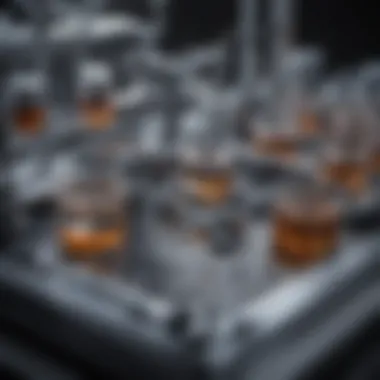Comprehensive Overview of the DNA Clean and Concentrator Kit


Intro
Molecular biology has come a long way, and at the heart of many groundbreaking discoveries is the DNA Clean and Concentrator Kit. This remarkable tool plays a crucial role in the purification and concentration of nucleic acids, making it a staple for students, researchers, educators, and professionals alike.
When you consider the intricacies of genetic research, the quality of your DNA sample can be the difference between a failed experiment and a successful one. The kit steps in to streamline the process, allowing users to achieve optimal results without the hassle. In this guide, we'll explore the nitty-gritty of how this kit works, the applications it spans across different scientific disciplines, and the best practices for its use.
Summary of Objectives
This article aims to demystify the workings of the DNA Clean and Concentrator Kit, shedding light on its operational mechanisms and its effectiveness relative to alternative methods. By diving deep into the technology and procedures behind the kit, readers will gain a clearer understanding of how it fits into the broader landscape of molecular biology.
Importance of the Research
In an era where genetic information is increasingly pivotal, purifying DNA samples efficiently and effectively is more important than ever. The ability to concentrate nucleic acids from various samples can propel research efforts forward, from medical applications to agricultural advancements. The insights provided in this guide could enhance experimental outcomes, making it a timely resource in the world of science.
Results and Discussion
Presentation of Findings
Through detailed examination, we’ll analyze the kit’s effectiveness in purifying and concentrating DNA. Users have reported a remarkable increase in yield and purity, directly impacting the success of downstream applications such as cloning, sequencing, and genotyping. Many laboratories have adopted the kit for its efficiency and reliability.
Implications of Results
The impacts of adopting this kit extend beyond just improved experimental results. For instance, in clinical settings, where sample integrity is paramount, the DNA Clean and Concentrator Kit ensures that researchers can work with confidence in the quality of their nucleic acids. Additionally, it has been highlighted that using this kit can significantly reduce the time needed for preparatory procedures, facilitating a more streamlined workflow in lab environments.
"The DNA Clean and Concentrator Kit has transformed how we approach sample preparation. It's a game-changer for both novice and experienced researchers!"
By addressing these concerns, readers can appreciate not only how the kit functions but also the profound effects its optimal use can have on scientific discovery.
Intro to DNA Purification
DNA purification holds a pivotal role in molecular biology research, acting as a bridge between raw samples and valid experimental outcomes. When scientists or researchers begin any sensitive molecular procedures, the quality of DNA they start with can significantly dictate the success or failure of their work. Contaminated or degraded DNA can skew results, causing more wasted time and resources than anyone would like to admit. Thus, understanding how to effectively purify and concentrate DNA becomes indispensable.
Importance of DNA Purification in Research
In research labs, purified DNA is the foundation upon which myriad experiments are built. Techniques such as polymerase chain reaction (PCR), sequencing, and cloning depend on high-quality nucleic acids. Researchers need to ensure that they are working with material that is free from inhibitors or impurities that can interfere with downstream applications. The necessity of clean DNA cannot be overstated: for example, in clinical settings, even a trace of contaminants can alter diagnostic results, leading to misguided treatments and misunderstandings among practitioners.
Moreover, a robust purification process leads to improved yields. When DNA is purified efficiently, the amount recovered can be substantial, reducing the need for retesting and additional sample collection. This efficiency not only conserves finite biological resources but also streamlines the workflow within a lab setting.
Overview of DNA Concentration Techniques
Once DNA is purified, researchers often seek to concentrate it for various applications. Concentration techniques can vary widely depending on the specific needs of an experiment, the initial sample volume, and the desired final concentration.
Common techniques for concentrating DNA include:
- Precipitation: Often achieved using alcohols like ethanol or isopropanol, allowing for the recovery of nucleic acids by aggregating them out of solution.
- Silica Gel Columns: Leveraged for their high affinity for nucleic acids, this approach can quickly isolate and concentrate DNA by binding it to a solid phase, followed by washing out impurities.
- Magnetic Bead-Based Methods: Utilize magnetic particles that can conveniently capture and separate DNA from contaminants under the influence of a magnetic field.
These methods each have their strengths and weaknesses. While silica column techniques are often straightforward, they may not perform equally well across various sample types. Similarly, magnetic bead-based techniques are versatile and can minimize contamination; however, they sometimes require specialized equipment. Understanding these various methods allows researchers to select the most suitable technique based on their unique research requirements.
In summary, an incisive grasp of DNA purification and concentration is crucial for researchers aiming for high-quality data and successful outcomes in their experiments. This leads us into further discussions around specific tools and kits available, such as the DNA Clean and Concentrator Kit, which streamline these processes effectively and efficiently.
The DNA Clean and Concentrator Kit Defined
The DNA Clean and Concentrator Kit plays a vital role in molecular biology, offering researchers an effective means to purify and concentrate nucleic acids. This kit streamlines workflows, allowing for efficient isolation of high-quality DNA from a variety of samples. As the accuracy and reliability of experimental results hinge significantly on the quality of the nucleic acids used, understanding the components and functionality of this kit is essential for any scientist in the field.
Components of the Kit
The backbone of the DNA Clean and Concentrator Kit lies in its thoughtfully designed components, which work synergistically to facilitate the purification process. Key elements include:


- Silica-based Membrane: At the heart of the kit's operation, the silica membrane selectively binds DNA while allowing contaminants to pass through. This selectivity is crucial for achieving clean results.
- Buffer Solutions: The kit includes specially formulated buffer solutions that optimize the binding and wash steps. These buffers help to remove impurities effectively while stabilizing the DNA.
- Collection Tubes: These are designed to fit the silica membrane and capture the purified DNA, ensuring minimal loss during transfer.
- Elution Buffer: A necessary component used to release the bound DNA from the silica membrane, ensuring that the final yield is maximized and of high quality.
While each component serves a specific purpose, their collective functionality ensures that researchers obtain purified DNA with minimal handling and contamination risk.
How the Kit Works
The operation of the DNA Clean and Concentrator Kit can be understood through a stepwise breakdown of its process. Here's how it goes:
- Sample Preparation: The initial step involves mixing your sample containing DNA with the provided binding buffer. This step is crucial as it primes the silica membrane for effective DNA capture.
- Binding Phase: Once mixed, the solution is added to the silica membrane column. Here, DNA binds to the silica while proteins and other contaminants are washed away, a dance that keeps your target nucleic acid clean.
- Washing Steps: The kit entails several washing phases using the washing buffer. These steps are imperative because they eliminate any residual contaminants, ensuring high-purity DNA in the end.
- Elution: Finally, the elution buffer is added, allowing the bound DNA to be released from the silica membrane. This step results in a concentrated DNA solution that is ready for downstream applications.
A thorough understanding of each phase in the process helps users tailor their experiments for optimal outcomes, whether it be for cloning, sequencing, or other genetic analyses.
In summary, the careful design and functioning of the DNA Clean and Concentrator Kit simplify the nucleic acid purification process. Mastering its components and workings will undoubtedly lead to improved experimental conditions, making it an indispensable tool in the lab.
Applications of the DNA Clean and Concentrator Kit
Understanding the diverse applications of the DNA Clean and Concentrator Kit is crucial for anyone engaged in molecular biology. This kit serves as a pivotal resource, streamlining various laboratory protocols while ensuring high yields of purified DNA. Whether one is conducting experiments in academic settings, clinical environments, or commercial labs, knowing when and how to deploy this kit can substantially enhance the quality of results obtained.
Molecular Cloning
Molecular cloning is a technique that enables scientists to replicate specific DNA sequences. The DNA Clean and Concentrator Kit plays a vital role in this process by allowing researchers to purify the DNA fragments necessary for cloning. After gel extraction or PCR amplification, these tobacco-like strands often come laden with unwanted impurities, such as residual enzymes and nucleotides.
By using the kit, researchers can efficiently remove these contaminants, ensuring that only high-quality DNA is used for the cloning process. This purification not only enhances the efficiency of ligation reactions but also increases transformation rates, leading to a better yield of recombinants. This efficiency is crucial as even a small amount of contamination can interfere with the success of the cloning process, jeopardizing the entire experiment.
PCR Product Cleanup
When working with Polymerase Chain Reaction (PCR), amplicons generated can be tainted with extraneous material. These impurities can lead to nonspecific results if not adequately addressed. The DNA Clean and Concentrator Kit is perfectly equipped for this cleanup task. Users can quickly remove excess primers, dNTPs, and enzymes, ensuring that only the target DNA is left behind.
The process is straightforward: the user mixes the PCR product with the provided buffer, places the mixture into the spin column, and performs a series of centrifugation steps. In doing so, they separate the desired product from unwanted constituents in mere minutes. This cleanup step is essential for downstream applications where high-purity DNA is necessary, such as cloning, sequencing, or any reaction sensitive to contaminants.
Preparation for Next-Generation Sequencing
Next-Generation Sequencing (NGS) has revolutionized genetic research, and preparing samples for sequencing is a meticulous process. The DNA Clean and Concentrator Kit is integral in ensuring that the DNA libraries are free from contaminants that could obstruct the sequencing process.
Contaminated libraries can yield inaccurate data, leading to misinterpretations. The kit’s efficacy lies in its ability to recover even low quantities of DNA from pooling of samples, making it an excellent choice for NGS preparation. It allows researchers to achieve higher throughput, ensuring that the data generated is of superior quality and reliability.
Other Research Applications
Beyond molecular cloning, PCR cleanup, and NGS preparation, the DNA Clean and Concentrator Kit finds its utility in various other research avenues. For example, it can be employed in genotyping studies, which require precise purification of DNA from different sources. Furthermore, it's often used to prepare samples for techniques like real-time PCR, where any contamination could skew quantitative results.
Another less-discussed application includes using this kit in forensic science, where obtaining clean DNA from degraded samples is critical. The ability to purify DNA quickly can make a crucial difference in generating usable profiles from limited samples.
In summary, the multifaceted applications of the DNA Clean and Concentrator Kit exemplify its significance in modern molecular biology. Whether one is engaging in basic research or advanced analytical techniques, leveraging this kit enhances the reliability and reproducibility of experimental outcomes.
Comparison with Alternative Methods
In the realm of DNA purification, researchers often face a veritable smorgasbord of techniques, each with unique attributes and benefits. Understanding these alternative methods is paramount, not only to appreciate the DNA Clean and Concentrator Kit's strengths but also to make informed decisions tailored to specific experiments. It’s like choosing the right tool from a toolbox; each has its own purpose, and knowing that purpose can significantly enhance outcomes.
Silica Column-Based Methods
Silica column-based methods have been staples in the DNA purification landscape for years. These techniques rely on silica's affinity for nucleic acids when in the presence of high salt concentrations. When a sample passes through these columns, DNA binds to the silica, allowing contaminants to be washed away. After a series of washes, the purified DNA is eluted with a low-salt buffer or water.
Benefits of Silica Columns:
- Effective Binding: Silica reliably binds nucleic acids, resulting in high-purity DNA.
- Scalability: These methods can be scaled up or down depending on the quantity of the sample.


However, there are also notable drawbacks.
- Time-Consuming: The multi-step process can feel like watching paint dry, particularly when you’re eager to move on to the next stage of your research.
- Variable Yields: Factors like sample type might affect how much DNA you end up with, leading to unpredictable results in some cases.
Magnetic Bead-Based Techniques
Turning the tide are magnetic bead-based techniques, which have risen in popularity. These methods utilize specially coated magnetic beads that bind nucleic acids. By applying a magnet to a tube containing the sample, researchers can easily separate the beads with the bound DNA from the unwanted materials. This technique often facilitates faster and easier handling.
Advantages of Magnetic Beads:
- Quick Separation: Thanks to the magnetic properties, separating the DNA from impurities is a breeze.
- Reduced Hands-On Time: This method often requires fewer steps, conserving both time and effort.
Conversely, it is worth noting that magnetic bead-based methods also come with a set of challenges.
- Cost Implications: The beads can be pricier than silica columns, which can add up if you’re on a tight budget.
- Potential for Incomplete Binding: Some users report less reliable binding, especially if their samples are tricky, such as those with high levels of contaminants.
Precipitation Methods
Then we have precipitation methods, which might take you back to your high school chemistry class. This approach typically involves adding alcohol or acetone to a DNA solution, which causes the DNA to precipitate out of the solution. After centrifugation, the DNA can be collected as a pellet.
Pros of Precipitation Methods:
- Inexpensive: You can often achieve satisfactory results using common lab reagents, reducing costs drastically.
- High Yield: Researchers often find they can recover a larger amount of DNA, which can be a significant advantage in certain experiments.
But, as with any technique, there are downsides:
- Time-Intensive Protocols: From adding reagents to centrifuging, this method can take longer than other techniques and might test your patience.
- Contamination Risk: If not done with care, contaminants can be co-precipitated with the DNA, leading to less pure samples.
In comparing these methods with the DNA Clean and Concentrator Kit, the choice becomes clear depending on the specific requirements of your project. Familiarity with these alternatives enables researchers to optimize their workflows, ensuring they select the best option tailored to their unique conditions.
Operational Protocols
The section on Operational Protocols is vital in this guide as it lays down the specific steps and best practices that users should follow when utilizing the DNA Clean and Concentrator Kit. Proper operational protocols not only dictate the efficiency of the purification process but also ensure that the integrity of the DNA is maintained throughout. Without a systematic approach, one may easily compromise the yield or quality of the final product.
Step-by-Step Guidelines for Use
Utilizing the DNA Clean and Concentrator Kit effectively requires meticulous adherence to a set of step-by-step guidelines. Here’s a detailed overview:
- Preparation: Start by gathering all necessary materials, including the DNA Clean and Concentrator Kit components, pipettes, microcentrifuge tubes, and your sample.
- Sample Input: Determine the volume of your sample. Make sure to measure it accurately and place it into a centrifuge tube. This step is crucial as inaccurate measurements could lead to waste or insufficient purification.
- Buffer Addition: Add the appropriate binding buffer to your sample as indicated in the kit's instructions. It's essential to mix it gently to avoid foaming, which could interfere with the binding process.
- Binding Phase: Transfer the mixture into the column provided in the kit. Centrifuge it as specified to allow the DNA to bind to the column effectively.
- Washing Cycle: Follow by washing the column with the provided wash buffer. This step eliminates contaminants and unbound substances, ensuring a pure DNA extract. Remember to centrifuge as per the recommended time.
- Elution: Finally, elute the DNA in an appropriate volume of elution buffer or water. This step releases the purified DNA from the column.
- Storage: Store the eluted DNA at -20°C for long-term use. If necessary, assess the quality using a spectrophotometer or gel electrophoresis.
Properly following the step-by-step protocol enhances yields and minimizes contamination risk, which is essential for reliable experimental outcomes.
Recommended Practices
In addition to adhering to the protocols, following recommended practices can further optimize results with the DNA Clean and Concentrator Kit:
- Use Fresh Buffers: Always prepare fresh buffers. Stale buffers may affect the performance of the kit and lead to suboptimal results.
- Minimizing Contaminants: Handle samples in a clean environment. Contamination can drastically compromise DNA quality.
- Keep Everything Cold: During the protocol, maintain samples on ice when appropriate. This practice can reduce the degradation of nucleic acids.
- Avoiding Repetitive Freezing: Freeze and thawing of samples should be minimized. Each cycle can lead to DNA degradation.
- Label Everything Clearly: Label your tubes and solutions clearly to avoid mix-ups, especially during complex experiments.
Incorporating these guidelines and practices into the daily laboratory workflow can significantly improve the outcomes of DNA purification processes. By treating each step with the diligence it deserves, researchers can ensure that they are maximizing the potential of the DNA Clean and Concentrator Kit.
Considerations and Limitations
When working with the DNA Clean and Concentrator Kit, it’s essential to keep certain constraints in mind to optimize the purification and concentration of DNA. This section dives into key considerations and limitations that users might encounter, shedding light on their significance in the overall laboratory experience.
Yield Variability


Yield variability in DNA purification can be a sticking point for researchers relying on consistent results. With the DNA Clean and Concentrator Kit, the yields can fluctuate based on several factors. First and foremost, starting DNA quality profoundly impacts the end yield. When starting with high-quality DNA from clean samples, users are likelier to hit the jackpot with their recovery. On the flip side, DNA sourced from complex biological matrices might yield less.
Additionally, pipetting technique matters. Precise pipetting ensures maximum collection of the solution during each step, and those who might rush through risk losing vital material. Also, inconsistent sample volumes can create disparities. Using the right volume supports reproducibility.
Therefore, it’s wise to establish control parameters, perhaps by testing different input amounts and sample types to gauge expected yields.
Contamination Risks
Contamination poses another concern in DNA purification processes, and it can sneak up on the best of us. While the DNA Clean and Concentrator Kit is designed with efficiency in mind, every step taken during sample handling can introduce risks.
It's imperative to operate under sterile conditions, as foreign nucleic acids can compromise the integrity of results. Using clean pipette tips and uncontaminated containers is just good practice. The importance of this cannot be overstated—improper handling could lead to cross-contamination, potentially generating false positives or misleading outcomes.
Moreover, environmental factors must not be overlooked. Airborne contaminants or those sourced from reagents can infiltrate a sample during processing. Regularly evaluating the supplies and materials used in conjunction with the kit can mitigate these risks.
Proper lab protocols and a disciplined approach can greatly reduce the threat of contamination, ensuring integrity of results.
To sum it up, considerations regarding yield variability and contamination risks are paramount when utilizing the DNA Clean and Concentrator Kit. Addressing these elements head-on not only improves the quality of the work but also increases the reliability of the findings.
Future Prospects in DNA Purification Technologies
In today’s rapidly evolving world of molecular biology, the purification and concentration of DNA are at the forefront of research advancements. Continued innovation in this area has become a game-changer for laboratories, enriching our understanding of genetics and genomes. This section explores the future directions of DNA purification technologies, emphasizing their relevance and the benefits they bring to modern science.
Emerging Techniques
The horizon of DNA purification is expanding with novel techniques gaining traction. Notably, microfluidics stands out among these advancements, enabling highly precise manipulation of small volumes of fluids. This method can yield better purity and higher concentrations of DNA while using fewer reagents. Moreover, nanotechnology is making waves, particularly in the development of nanoscale materials that offer enhanced binding properties for efficient DNA capture.
- Benefits of Microfluidics
- Nanoscale Materials
- Enables rapid processing
- Requires smaller sample sizes
- Reduces the risk of contamination
- Improved affinity for nucleic acids
- Greater selectivity leading to purer outcomes
- Potential for multiplexing, making it possible to analyze multiple DNA samples simultaneously
These emerging techniques show promise in not only enhancing the effectiveness of DNA purification but also in contributing to cost-effective and eco-friendly laboratory practices.
Advancements in User-Friendly Products
Another critical development is the focus on creating user-friendly products that cater to both experienced researchers and those who are new to the field. Simplified protocols have been designed to ensure that even individuals without extensive backgrounds in molecular biology can achieve successful outcomes. Kits equipped with step-by-step instructions alleviate many of the challenges faced during traditional DNA purification processes.
- Key Features to Look For
- Ready-to-Use Reagents: Minimized preparation time means experiments can start sooner.
- Visual Protocols: Easy-to-follow flowcharts or infographic guides help reduce errors.
- Integrated Quality Control: Built-in checks to ensure the DNA purity and concentration are right where they should be.
These advances are aimed at democratizing access to sophisticated DNA manipulation techniques, propelling forward the research capacity in academic institutions, biotech companies, and even in field studies where immediate results can be crucial.
Looking ahead, the combination of emerging techniques with more accessible products is bound to foster significant breakthroughs in genetic research, paving the way for unprecedented discoveries in life sciences.
Epilogue
In the ever-evolving landscape of molecular biology, tools like the DNA Clean and Concentrator Kit stand as essential components for researchers dedicated to ensuring the purity and integrity of their nucleic acids. This article has laid out a comprehensive framework surrounding the use, applications, and limitations of this particular kit, allowing practitioners to make informed decisions about its utilization in various experiments.
Final Thoughts on the DNA Clean and Concentrator Kit
The significance of the DNA Clean and Concentrator Kit cannot be overstated in today's scientific environment. Its multi-faceted applications, ranging from molecular cloning to PCR product cleanup, highlight its versatility and necessity. With rising demands for accuracy in experimental results, the ability of this kit to effectively purify and concetrate DNA proves invaluable.
Moreover, the operational protocols shared throughout this guide emphasize the importance of meticulous practice. Researchers are urged to adopt these recommended practices to enhance yield and minimize contamination risks, ensuring that the DNA they extract meets the rigorous standards expected in modern research.
However, it's advisable to remain cognizant of the limitations accompanying its use. Yield variability and contamination risks are factors that cannot be overlooked. Recognizing these aspects fosters a more critical approach to experimental design.
"Mastering nucleic acid purification opens doors to innovation and discovery."
By integrating such technologies into research practices, the pursuit of excellence in scientific inquiry becomes not only achievable but routine.















